|
Dactylobatus Armatus
The skillet skate (''Dactylobatus armatus'') is a small-bodied, deepwater skate (fish), skate in the family Rajidae. Distribution and habitat The skillet skate is typically found at depths between . Found in the western central Atlantic, its range extends from South Carolina to southern Florida, the northern Gulf of Mexico, and the Caribbean coasts of Nicaragua and northern South America. Description The skillet skate is a small skate. Its total length is up to 32 cm. Its body is narrow and features a spatula-shaped lobe from the margin of each pectoral muscle. On the underside of the frontal disc, the skate displays characteristic spines. Relationship to humans This species is assessed as least concern. References Rajiformes Fish of the Atlantic Ocean Fish described in 1909 {{Rajiformes-stub ... [...More Info...] [...Related Items...] OR: [Wikipedia] [Google] [Baidu] |
Barton Appler Bean
Barton Appler Bean was an American ichthyologist, born May 21, 1860 in Lancaster County, Pennsylvania and died June 16, 1947 in Chemung, New York, after falling from a bridge. He was the brother of the ichthyologist Tarleton Hoffman Bean (1846-1916). He obtained a job at the National Museum of Natural History in Washington in 1881 where he worked for his brother. Barton became assistant in 1886 and assistant curator of the Division of Fishes in 1890. He retained this position until his retirement in 1932. Barton Bean also worked for the United States Fish Commission The United States Fish Commission, formally known as the United States Commission of Fish and Fisheries, was an agency of the United States government created in 1871 to investigate, promote, and preserve the fisheries of the United States. In 1 ... as an investigator. See also * :Taxa named by Barton Appler Bean References External links * American ichthyologists 1860 births 1947 deaths {{US-z ... [...More Info...] [...Related Items...] OR: [Wikipedia] [Google] [Baidu] |
Alfred Cleveland Weed
Albert Cleveland Weed was an American ichthyologist, known for expeditions to the Arctic, where he catalogued the region's fish. Weed was born in North Rose, New York, and earned his bachelor's degree at Cornell University. He was hired as assistant curator of the Field Museum of Natural History The Field Museum of Natural History (FMNH), also known as The Field Museum, is a natural history museum in Chicago, Illinois, and is one of the largest such museums in the world. The museum is popular for the size and quality of its educational ... in 1921. By his retirement, in 1942, he was serving as full curator of the Fishery department. He made multiple scientific field trips to Labrador and Greenland in the 1920s and 1930s. References {{authority control Weed, Alfred Cleveland Cornell University alumni American ichthyologists Explorers of the Arctic ... [...More Info...] [...Related Items...] OR: [Wikipedia] [Google] [Baidu] |
Skate (fish)
Skates are cartilaginous fish belonging to the family Rajidae in the superorder Batoidea of rays. More than 150 species have been described, in 17 genera.LAST, P.R. & SÉRET, B. & STEHMANN, M.F.W. & WEIGMANN, S. (2016) Skates, Family Rajidae. In: Last, P.R., White, W.T., Carvalho, M.R. de, Séret, B., Stehmann, M.F.W & Naylor, G.J.P (Eds.) Rays of the World. CSIRO Publishing, Melbourne: 204–363 Softnose skates and pygmy skates were previously treated as subfamilies of Rajidae (Arhynchobatinae and Gurgesiellinae), but are now considered as distinct families. Alternatively, the name "skate" is used to refer to the entire order of Rajiformes (families Anacanthobatidae, Arhynchobatidae, Gurgesiellidae and Rajidae). Members of Rajidae are distinguished by a stiff snout and a rostrum that is not reduced. Taxonomy and systematics Evolution Skates belong to the ancient lineage of cartilaginous fishes. Fossil denticles (tooth-like scales in the skin) resembling those of today's ... [...More Info...] [...Related Items...] OR: [Wikipedia] [Google] [Baidu] |
Rajiformes
Rajiformes is one of the four orders in the superorder Batoidea, flattened cartilaginous fishes related to sharks. Rajiforms are distinguished by the presence of greatly enlarged pectoral fins, which reach as far forward as the sides of the head, with a generally flattened body. The undulatory pectoral fin motion diagnostic to this taxon is known as rajiform locomotion. The eyes and spiracles are located on the upper surface of the head and the gill slits are on the underside of the body. Most species give birth to live young, although some lay eggs enclosed in a horny capsule ("mermaid's purse"). Characteristics Rajoids typically have a dorsoventrally flattened body. The snout is slender and pointed and the wide mouth, often covered with a fleshy nasal flap, is on the underside of the head. The eyes and well-developed spiracles are located on the top of the head. In most species, the spiracles are large and are the main means of drawing water in for respiration. There is no n ... [...More Info...] [...Related Items...] OR: [Wikipedia] [Google] [Baidu] |
Fish Of The Atlantic Ocean
Fish are aquatic, craniate, gill-bearing animals that lack limbs with digits. Included in this definition are the living hagfish, lampreys, and cartilaginous and bony fish as well as various extinct related groups. Approximately 95% of living fish species are ray-finned fish, belonging to the class Actinopterygii, with around 99% of those being teleosts. The earliest organisms that can be classified as fish were soft-bodied chordates that first appeared during the Cambrian period. Although they lacked a true spine, they possessed notochords which allowed them to be more agile than their invertebrate counterparts. Fish would continue to evolve through the Paleozoic era, diversifying into a wide variety of forms. Many fish of the Paleozoic developed external armor that protected them from predators. The first fish with jaws appeared in the Silurian period, after which many (such as sharks) became formidable marine predators rather than just the prey of arthropods. Most ... [...More Info...] [...Related Items...] OR: [Wikipedia] [Google] [Baidu] |
.jpg)

